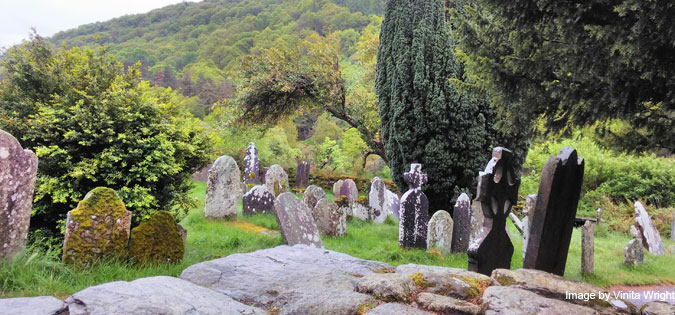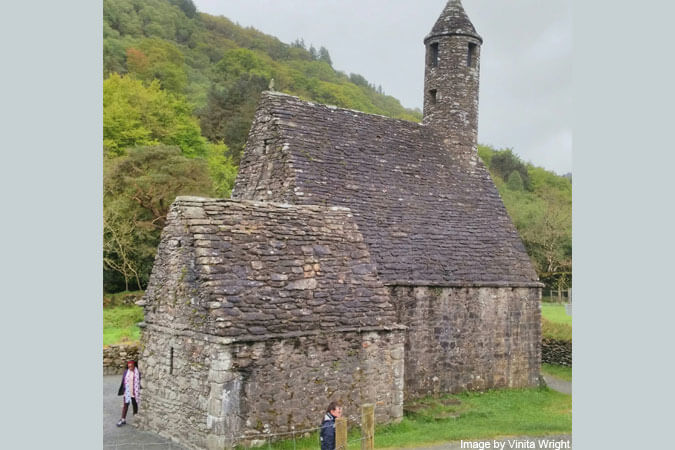 A few months ago, I went on pilgrimage to Ireland and Scotland, to visit sites important to Celtic Christianity. I had been on pilgrimage before but had never been to this part of the world. I was with a group of Episcopalians from my sister-in-law’s church in Florida. So, in addition to absorbing the pilgrimage, I was making a number of new friends.
A few months ago, I went on pilgrimage to Ireland and Scotland, to visit sites important to Celtic Christianity. I had been on pilgrimage before but had never been to this part of the world. I was with a group of Episcopalians from my sister-in-law’s church in Florida. So, in addition to absorbing the pilgrimage, I was making a number of new friends.
How does a person “do” pilgrimage? For someone like me, from the affluent, technological West, who spends so much of the day in her head, pilgrimage offers specific challenges. At each site, we were given ample information about its history and its impact on the Church. That was the easy part—taking in new information.
But true pilgrimage involves more than the mind. The purpose of physically traveling to a place is to experience it bodily. I stood in old graveyards and smelled nearby crops, felt the wind moving all around me, and heard birds, wind, conversations. My feet navigated uneven ground, ladders up high, ancient bell towers, and cold stone floors of pre-Christian tombs. As a pilgrim, I had to silence my thoughts and concentrate on the physical senses.
I believe that history has energy and that a site is made sacred (or not) by what has happened there. When I stand in the ruins of a church where spiritual masters taught and nurtured new believers, I am, in a mystical way, participating in that. When I look across hills and valleys from the spot where the ancient kings of Ireland were chosen and proclaimed, I am folded into that time—a time in which the Christian faith was moving through communities, without bloodshed for the most part, and influencing power, often in subtle ways. My sister-in-law, a midwife and nurse practitioner, did an additional walk to a place where babies were buried secretly because of shame or politics; there, she touched a root deeply connected to her profession.
 Another aspect of pilgrimage is a person’s emotional and intuitive response to it. Something in me responds to St. Brigid’s Well, where people journeyed to find healing. I saw the trees nearby adorned with hundreds of ribbons, baby boots, scarves, and other items that represented prayers made at that spot. I am on the healing prayer team in my church, and I experienced a visceral response to this place.
Another aspect of pilgrimage is a person’s emotional and intuitive response to it. Something in me responds to St. Brigid’s Well, where people journeyed to find healing. I saw the trees nearby adorned with hundreds of ribbons, baby boots, scarves, and other items that represented prayers made at that spot. I am on the healing prayer team in my church, and I experienced a visceral response to this place.
Pilgrimage reveals not only knowledge and wisdom about the site itself but also knowledge and wisdom about the pilgrim who lingers at the site. God has designed history, geography, prayer, tradition, and our own gifts to mingle in places where there is a sacred meeting. This is how this marvelous world was designed—to present all sorts of connections and resonances to anyone who will pay attention.
We make pilgrimages all the time—to see family or visit a hometown; to tour the house of a favorite author or artist or spiritual teacher; to revisit a place that touched us profoundly, either with joy or pain. What journey will you make in the next month or year? Where can you linger—with your mind, memory, emotions, gifts, and senses—and connect with the graces God has hidden there just for you?

Wow–that’s a great idea–a way to “go home” even if you can’t do it physically. Thanks for posting about this experiment of yours. I’m sure it will inspire others to try it or something similar.
You know, Vinita, I was surprised by the emotions my “virtual pilgrimage” aroused, and which, in turn, triggered many more memories – some good, others painful, but at the end of it all I was left with an overwhelming sense of gratitude towards God for having placed so many good people in my life during those formative years. Sometimes it’s in looking back that we can see just where our Lord accompanied us, giving us a greater confidence in his love for us.
Unable to return to the place of my birth and upbringing I “visited” via Google streetview a while back. The technology enabled me to travel around my old communities, remembering, cherishing and seeing, once again, those very places where I had spiritual encounters even as a small child and remembering those people who nudged me along my faith development.
Though it lacked the physical senses aspect so important on pilgrimage it was a good substitute – better than nothing – and meant a lot to me, an armchair pilgrim.
Beautiful! Such connection! Thank you!
Vinita – you knock it out of the park again. This article provides so many with a new sense of pilgrimage and its many meanings and gifts. Thank you for your many quality articles.
Thanks for your kind words!
To be a pilgrim is to “linger” as you have mentioned. That is such an important aspect and can be applied to our everyday life as pilgrims as well. Thank you for this timely reminder!